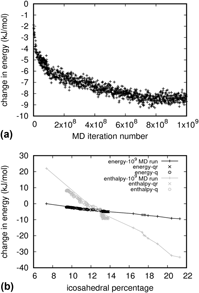Crossref Citations
This article has been cited by the following publications. This list is generated based on data provided by
Crossref.
Peng, Chuan-Xiao
Şopu, Daniel
Song, Kai-Kai
Zhang, Zhen-Ting
Wang, Li
and
Eckert, Jürgen
2017.
Bond length deviation in CuZr metallic glasses.
Physical Review B,
Vol. 96,
Issue. 17,
Kim, Sunghwan
and
Ryu, Seunghwa
2017.
Effect of surface and internal defects on the mechanical properties of metallic glasses.
Scientific Reports,
Vol. 7,
Issue. 1,
Küchemann, Stefan
Liu, Chaoyang
Dufresne, Eric M.
Shin, Jeremy
and
Maaß, Robert
2018.
Shear banding leads to accelerated aging dynamics in a metallic glass.
Physical Review B,
Vol. 97,
Issue. 1,
Wang, Yun-Jiang
Du, Jun-Ping
Shinzato, Shuhei
Dai, Lan-Hong
and
Ogata, Shigenobu
2018.
A free energy landscape perspective on the nature of collective diffusion in amorphous solids.
Acta Materialia,
Vol. 157,
Issue. ,
p.
165.
Derlet, P.M.
and
Maaß, R.
2018.
Thermally-activated stress relaxation in a model amorphous solid and the formation of a system-spanning shear event.
Acta Materialia,
Vol. 143,
Issue. ,
p.
205.
Liu, Chaoyang
and
Maaß, Robert
2018.
Elastic Fluctuations and Structural Heterogeneities in Metallic Glasses.
Advanced Functional Materials,
Vol. 28,
Issue. 30,
Derlet, P.M.
and
Maaß, R.
2018.
Local volume as a robust structural measure and its connection to icosahedral content in a model binary amorphous system.
Materialia,
Vol. 3,
Issue. ,
p.
97.
Küchemann, Stefan
Derlet, Peter M.
Liu, Chaoyang
Rosenthal, Daniel
Sparks, Gregory
Larson, William S.
and
Maaß, Robert
2018.
Energy Storage in Metallic Glasses via Flash Annealing.
Advanced Functional Materials,
Vol. 28,
Issue. 50,
Maaß, R.
and
Derlet, P.M.
2018.
Micro-plasticity and recent insights from intermittent and small-scale plasticity.
Acta Materialia,
Vol. 143,
Issue. ,
p.
338.
Kalcher, Constanze
Brink, Tobias
Rohrer, Jochen
Stukowski, Alexander
and
Albe, Karsten
2019.
Elastostatic loading of metallic glass-crystal nanocomposites: Relationship of creep rate and interface energy.
Physical Review Materials,
Vol. 3,
Issue. 9,
Li, Yu
Zhao, Liang
Wang, Hao
and
Li, Baohua
2019.
Synthesis of novel shape-stabilized phase change materials with high latent heat and low supercooling degree for thermal energy storage.
Journal of Materials Research,
Vol. 34,
Issue. 19,
p.
3263.
Lei, T.J.
DaCosta, L. Rangel
Liu, M.
Wang, W.H.
Sun, Y.H.
Greer, A.L.
and
Atzmon, M.
2019.
Microscopic characterization of structural relaxation and cryogenic rejuvenation in metallic glasses.
Acta Materialia,
Vol. 164,
Issue. ,
p.
165.
Das, Amlan
Derlet, Peter M.
Liu, Chaoyang
Dufresne, Eric M.
and
Maaß, Robert
2019.
Stress breaks universal aging behavior in a metallic glass.
Nature Communications,
Vol. 10,
Issue. 1,
Derlet, P.M.
and
Maaß, R.
2020.
Emergent structural length scales in a model binary glass - The micro-second molecular dynamics time-scale regime.
Journal of Alloys and Compounds,
Vol. 821,
Issue. ,
p.
153209.
Das, A.
Dufresne, E.M.
and
Maaß, R.
2020.
Structural dynamics and rejuvenation during cryogenic cycling in a Zr-based metallic glass.
Acta Materialia,
Vol. 196,
Issue. ,
p.
723.
Derlet, P. M.
2020.
Correlated disorder in a model binary glass through a local SU(2) bonding topology.
Physical Review Materials,
Vol. 4,
Issue. 12,
Maaß, R.
2020.
Beyond Serrated Flow in Bulk Metallic Glasses: What Comes Next?.
Metallurgical and Materials Transactions A,
Vol. 51,
Issue. 11,
p.
5597.
Accaputo, Giuseppe
Derlet, Peter M.
and
Arbenz, Peter
2021.
High Performance Computing in Science and Engineering.
Vol. 12456,
Issue. ,
p.
80.
Derlet, P.M.
and
Maaß, R.
2021.
Micro-plasticity in a fragile model binary glass.
Acta Materialia,
Vol. 209,
Issue. ,
p.
116771.
Derlet, P. M.
Bocquet, H.
and
Maaß, R.
2021.
Viscosity and transport in a model fragile metallic glass.
Physical Review Materials,
Vol. 5,
Issue. 12,






